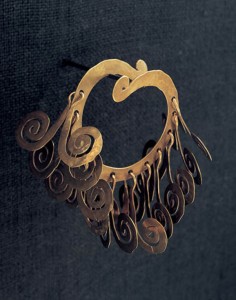« News US
Calder Jewelry at The Metropolitan Museum of Art

Alexander Calder (American, 1898-1976) Bracelet, ca. 1940. Brass wire, 2 x 3 ¼ x 3 ¼ inches. The Metropolitan Museum of Art, The Muriel Kallis Steinberg Newman Collection, Gift of Muriel Kallis Steinberg Newman, 2006 (2006.32.7). © 2008 Calder Foundation, New York / Artists Rights Society (ARS), New York
Exhibition Dates: December 9, 2008 - March 1, 2009
Exhibition Location: The Helen and Milton A. Kimmelman Gallery, Lila Acheson Wallace Wing
American-born artist Alexander Calder (1898-1976) is celebrated for his mobiles, stabiles, paintings, and objets d’art. The landmark exhibition “Calder Jewelry” is the first museum presentation dedicated solely to his extensive output of inventive jewelry. During his lifetime, Calder produced approximately 1,800 unique pieces of brass, silver, and gold body ornaments, often embellished with found objects such as beach glass, ceramic shards, and wood. “Calder Jewelry” will feature approximately 90 works-necklaces, bracelets, earrings, brooches, and tiaras-many of which were made as personal gifts for the artist’s family and friends. The exhibition was organized by the Norton Museum of Art, West Palm Beach, Florida, and the Calder Foundation, New York.
Among the most dramatic works in the exhibition are four large and dynamic pieces of Calder jewelry that were donated to the Metropolitan Museum in 2006 by Chicago collector Muriel Kallis Steinberg Newman.
“The recent gift of Muriel Newman’s magnificent Calder jewelry to the Metropolitan made it clear to us that the subject deserved the extended examination that this exhibition affords. I am certain that our audience will delight in Calder’s inventiveness and be seduced by his virtuosic technique and lighthearted humor,” remarked Gary Tinterow, Engelhard Curator in Charge of the Metropolitan Museum’s Department of Nineteenth-Century, Modern, and Contemporary Art.
As early as 1906, at the age of eight, Alexander Calder fashioned jewelry for his sister’s dolls from scraps of fine copper wire found on the street. In 1928, while continuing to explore wire sculpture, Calder created one of his earliest pieces of jewelry as an adult-a necklace with a dangling, abstracted fly. He created jewelry with increasing frequency through the 1930s, 1940s, and 1950s and continued to make jewelry until the end of his life.
Calder possessed an uncanny ability to synthesize a variety of influences from the world around him to create often simple, always meaningful, and ultimately modern jewelry. In the early 20th century, many avant-garde artists began to collect African tribal art and to reference it in their paintings and sculptures. Likewise, Calder’s brooches, tiaras, and necklaces have more in common with the pectorals, collars, diadems, and neckpieces made by ancient cultures than traditional western European jewelry. For example, Calder repeatedly incorporated the spiral-a typical motif in late Bronze Age artifacts-into his jewelry, as well as his wire figures, drawings, paintings, and other decorative arts. The artist’s personal collections, which included objects from African, Oceanic, and Precolumbian cultures, substantiate his eclectic taste.
Calder’s exploration of jewelry in the 1930s also coincided with his burgeoning interest in Surrealism. As his largest and most dramatic ornaments are unwieldy to wear, Calder’s jewelry may be seen as a Surrealistic strategy to entrap the wearer into participating in an art performance or being metamorphosed by the object. Among those who wore his jewelry were sophisticated art aficionados and artists, such as Peggy Guggenheim, Mary Rockefeller, French actress Jeanne Moreau, and Georgia O’Keeffe.
His sculptural art, regardless of category, has less to do with solidity than with lightness, air, motion, and graceful formal relationships. Calder’s sense of economy, balance, and adaptability, so characteristic of the artist’s much larger and more familiar mobiles and stabiles, extends to his jewelry. While Calder’s more diminutive avant-garde creations converged closely with the aesthetics of the modern age, they remain unmistakably Calder.
“Calder Jewelry” was organized by Alexander S. C. Rower, Director of the Calder Foundation, and Mark Rosenthal, Adjunct Curator of Contemporary Art at the Norton Museum of Art. The exhibition is organized at the Metropolitan Museum by Jane Adlin, Associate Curator in the Department of Nineteenth-Century, Modern, and Contemporary Art.
The exhibition is accompanied by a book published by the Calder Foundation and distributed by Yale University Press ($65 hardcover, $50 softcover). The book is edited by Alexander S. C. Rower and Holton Rower and features essays by Jane Adlin and Mark Rosenthal on the relationship of Calder’s jewelry creations to the history of jewelry and the artist’s other endeavors as a sculptor.
The Metropolitan Museum will offer an array of education programs in conjunction with “Calder Jewelry.” A Saturday at the Met program on February 7, 2009, to be introduced by Jane Adlin, will include a lecture by Mark Rosenthal, a screening of the short film Calder’s Circus, and a conversation between Alexander S. C. Rower and Marla Prather, Special Consultant in the Department of Nineteenth-Century, Modern, and Contemporary Art. The Museum will also offer education programs for families and teachers, and the exhibition will be featured on the Museum’s website at www.metmuseum.org.
“Calder Jewelry” was previously on view at the Norton Museum of Art and the Philadelphia Museum of Art. It will also travel to the Irish Museum of Modern Art, Dublin (March 31-June 22, 2009).
Filed Under: News US


































